MARIANI’S
March
2, 2008
NEWSLETTER
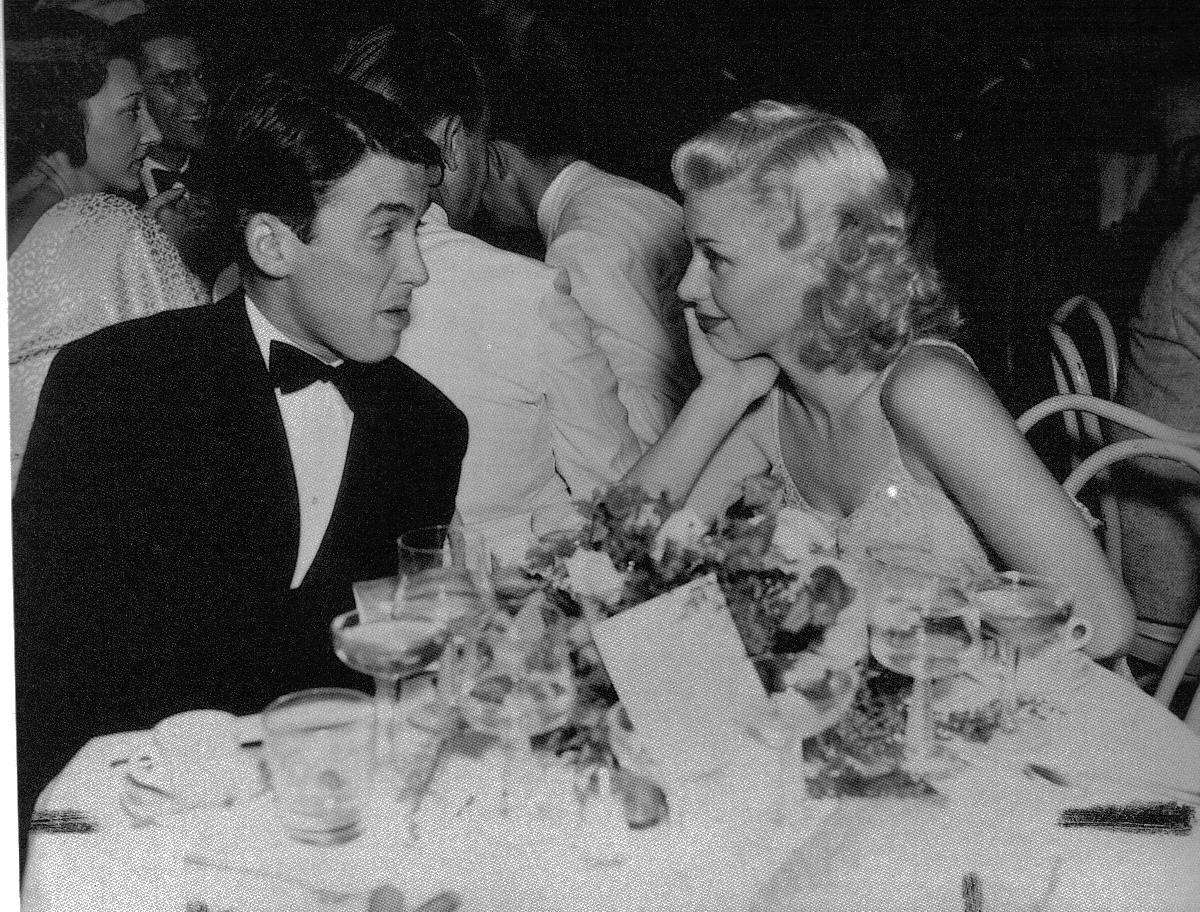
Jimmy Stewart and Ginger Rogers at The Trocadero, Hollywood, circa 1939
NEW! Click esquire.com
to go to my new column at Esquire
Magazine.
ARCHIVE: Readers may now access
an
Archive of all past newsletters--each annotated--dating back to July,
2003, by simply clicking on www.johnmariani.com/archive
Restaurant
Index: A complete list of restaurants covered in this newsletter
since 2003. Please
click here.
SUBSCRIBE AND
UN-SUBSCRIBE: You may subscribe anyone you wish
to this newsletter--free of charge--by
clicking here.
In
This Issue
NEW YORK CORNER: DOVETAIL by John Mariani
NOTES FROM THE WINE CELLAR: Cuvée R. Lalou Hits the Mark by John Mariani
QUICK BYTES
~~~~~~~~~~~~~~~~~~~~~~~~~~~~~~~~
TUSCAN RESORTS, Part Two
by John Mariani
 Il Borgo
Il Borgo011-39-0577-877700
www.castellobanfilborgo.com
Let's get it out of the way that I am not the John F. Mariani who is the founder of Castello Banfi, though I truly wish I were related to the family in some way. He is an Italian-American (recently awarded "Man of the Year" by Wine Enthusiast Magazine) who made a great fortune importing Italian wines and who also made a great impression on Tuscany by buying up vast amounts of vineyard land and planting, mostly, sangiovese grosso in order to make Brunello di Montalcino. His success there also helped the success of other Brunello producers around Castello Banfi, for the Marianis had ampellographers identify the healthiest, best clones to plant in the soil around Montalcino, then graciously and freely shared that information with the other vintners.
The Banfi estate (above), where he and members of his family often reside throughout the year, is as remarkable for its innovative viticultural technology as for its attention to the land and to sustainable viticulture, obvious to anyone who visits the region. There is a state-of-the-art tasting room and enology museum on the Castello property, which has been expensively restored to architectural grandeur. And now there is a marvelous new place to stay on the Banfi property,
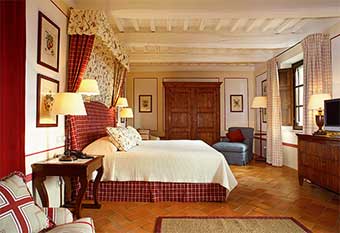 along with two terrific restaurants, one with a Michelin
star.
The new
residences are called Il Borgo, designed by Federico Forquet of Cetona, who has provided
each of the 14 rooms and suites with individual decor, each expressive
of the country setting, with beautiful fabrics, fine artwork, and
splendid, big
bathrooms. Each offers a
King-sized bed,
while the five suites have an additional Queen-size
sofa bed in a separate room. The
most modern amenities are provided here--flat screen t.v., high-speed
internet connection-- and several of the rooms have a separate dressing
area, writing desk and breakfast
table. There is also a Reading
Room, a pergola garden with grand panoramas of the valley, a charming Breakfast Room (which serves an excellent
breakfast), a Swimming Pool, and
Fitness Room.
along with two terrific restaurants, one with a Michelin
star.
The new
residences are called Il Borgo, designed by Federico Forquet of Cetona, who has provided
each of the 14 rooms and suites with individual decor, each expressive
of the country setting, with beautiful fabrics, fine artwork, and
splendid, big
bathrooms. Each offers a
King-sized bed,
while the five suites have an additional Queen-size
sofa bed in a separate room. The
most modern amenities are provided here--flat screen t.v., high-speed
internet connection-- and several of the rooms have a separate dressing
area, writing desk and breakfast
table. There is also a Reading
Room, a pergola garden with grand panoramas of the valley, a charming Breakfast Room (which serves an excellent
breakfast), a Swimming Pool, and
Fitness Room.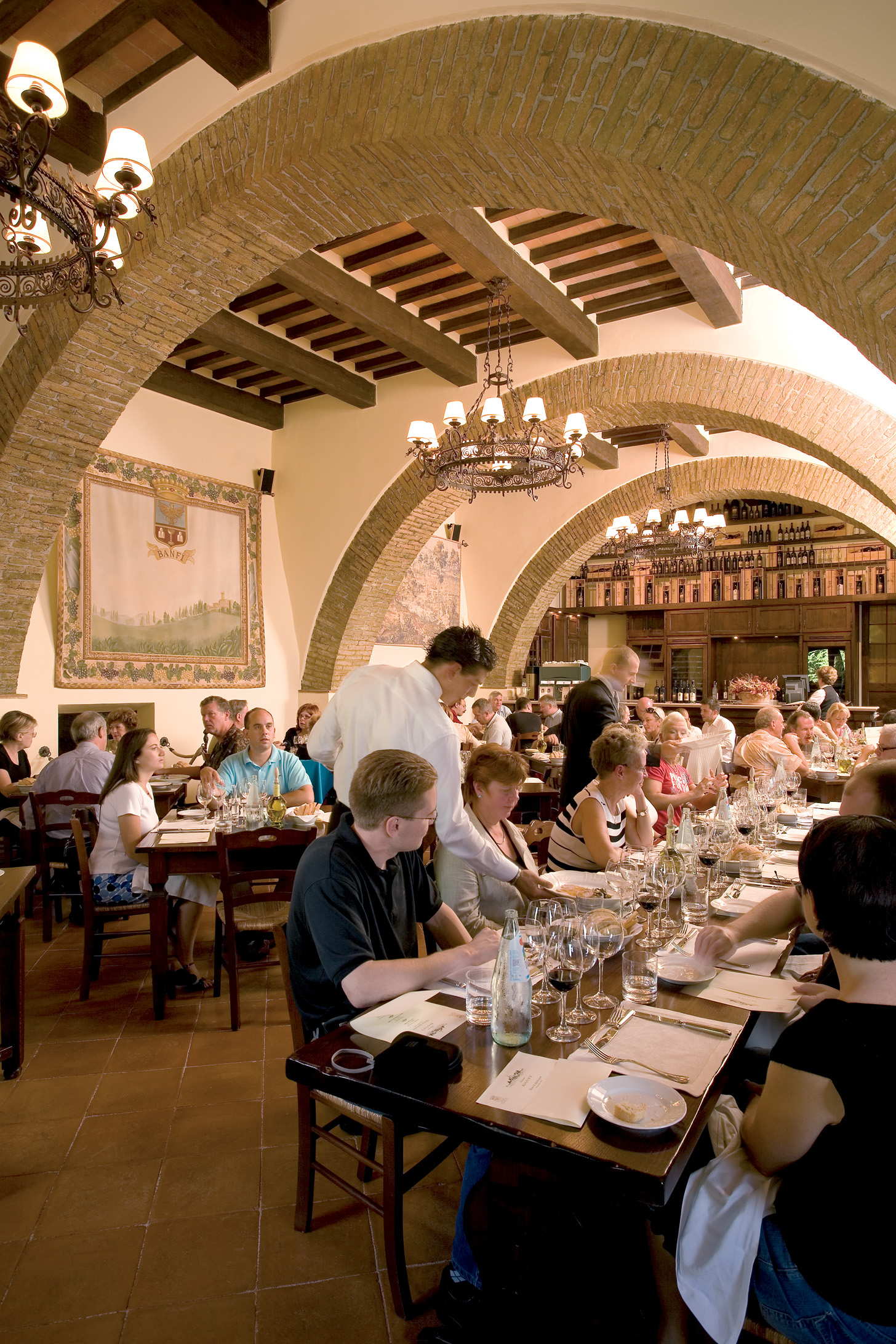 The casual trattoria on the property is La Taverna (left), and
it may well be the best of its kind in
the region. The menu teems with Tuscan specialties, and we dove
right in, pretty much leaving it to the chef to send out what he
wished. This began with a nibbles of crostini toast with funghi porcini and a chicken liver
spread; little polenta
sandwiches with pork, and a sformato
of cabbage and bacon flan with
greens, and slices of fatted soppressata
with lentils, accompanied by one of the Banfi wines, the light San Angelo Pinot Grigio 2006. A Centine Rosé 2006, blended
from cab, sangiovese. and merlot, accompanied a spelt
soup
with porcini and sausage, and
there was also ribollita soup
with beans. The pasta was tortelli
with a lusty meat ragù.
A succulent fillet
of roast
pork with potato flan and Swiss chard followed, with the delicious Cum
Laude 2004, a sangiovese-cabernet-merlot-syrah blend, then a
selection of Tuscan sheep's cheeses with honey and
pine nuts, with which we savored a big, bold Brunello di Montalcino 2001.
The casual trattoria on the property is La Taverna (left), and
it may well be the best of its kind in
the region. The menu teems with Tuscan specialties, and we dove
right in, pretty much leaving it to the chef to send out what he
wished. This began with a nibbles of crostini toast with funghi porcini and a chicken liver
spread; little polenta
sandwiches with pork, and a sformato
of cabbage and bacon flan with
greens, and slices of fatted soppressata
with lentils, accompanied by one of the Banfi wines, the light San Angelo Pinot Grigio 2006. A Centine Rosé 2006, blended
from cab, sangiovese. and merlot, accompanied a spelt
soup
with porcini and sausage, and
there was also ribollita soup
with beans. The pasta was tortelli
with a lusty meat ragù.
A succulent fillet
of roast
pork with potato flan and Swiss chard followed, with the delicious Cum
Laude 2004, a sangiovese-cabernet-merlot-syrah blend, then a
selection of Tuscan sheep's cheeses with honey and
pine nuts, with which we savored a big, bold Brunello di Montalcino 2001.For dessert we somehow managed to vanquish chocolate panna cotta, a tortino of apple, and tiramisù, with a sip or two of lusciously sweet Florus 2005 Moscadello dessert wine. And dinner still lay ahead.
But before that we visited the nearby town of Montalcino (below), with its own formidable castello, and narrow streets that must be climbed to be conquered. The town has become quite a tourist spot, and although we were there in December, several wineshops were open featuring the scores of wines made in the area. From any point in the walled town you look down over a vast expanse of misty Tuscan hills and plains as peaceful as any panorama in Italy.
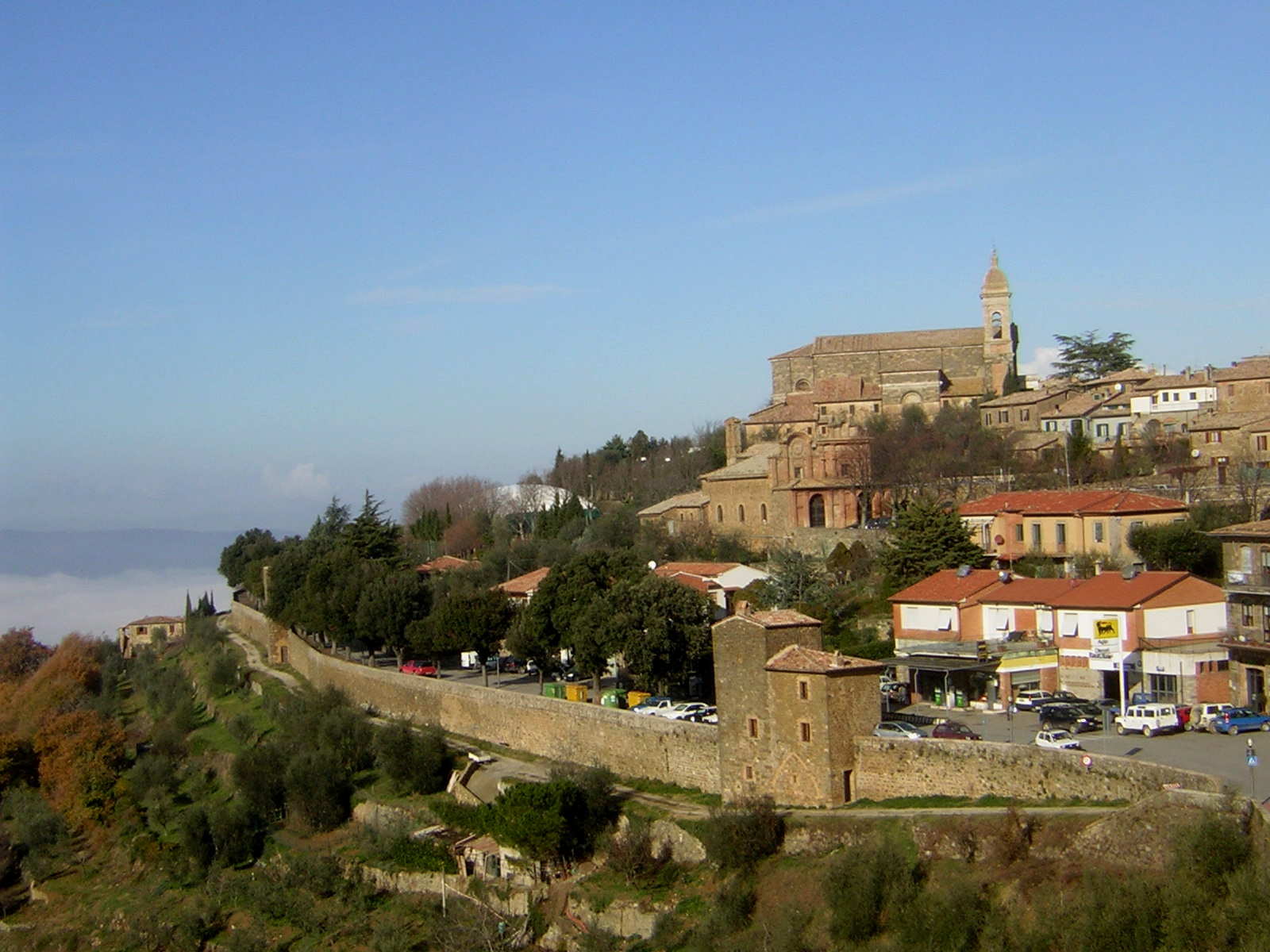
Dinner that evening was at the Ristorante (below), where young chef Guido Haverkock has garnered a Michelin star--not surprising since the illustrious Heinz Beck of La Pergola in Rome is consulting chef here. As rustic and farmhouse like La Taverna is, the Ristorante is the epitome of a fine country estate dining room, with beautifully frescoed walls, fine tablesettings and wineglasses, and a menu that is among the finest is Tuscany, certainly ranking with places like Enoteca Pinchiorri in Florence, Il Pirana in Prato, and La Tenda Rossa in San Casciano--all with their own Michelin stars.
We had a menù degustazione beginning with fillets of John Dory wrapped in bacon with cherry tomato jam, capers, and sour cream, accompanied by clean, grass-rich Serena Sauvignon Blanc 2006. Spaghetti alla chitarra with zucchini and mullet
 bottarga roe
followed, with a pleasantly acidic-fruity Fontanelle 2006
Chardonnay, then a magnificent lasagnetta
with hare ragù,
celeriac purée, currants, and bitter cocoa
as an
accent to the richness of the sauce. With this we drank the superb SummuS 2003, a blend of
sangiovese with some cabernet and a fruity touch of syrah. Two
hearty entrees came next, though in portions
that allowed us to finish both with gusto--a fillet of veal in a light
garlic crust with Swiss chard and Port reduction, and beef cheeks
braised in red wine on lemon-flavored potato puree. With the
first we drank ExelsuS 2001, a
cabernet-merlot blend that went beautifully with the veal; I
was fearful the lemon would interfere with the brawn of Brunello di
Montalcino Poggio Alle Mura 1999, made from 100 percent
sangiovese, but in fact, the fruit added a slight citrus
enhancement. A wonderful display of cheeses with the magnificent Brunello di Montalcino Riserva
Poggio all'Oro 1995, a single vineyard sangiovese aged five
years, showed this great
vintage to marvelous effect. Dessert was a warm chocolate cake
with pear ragù in vin burl with vanilla ice cream, washed down
with sparkling Rosa Regale 2006,
a very pretty and aromatic sparkling wine.
bottarga roe
followed, with a pleasantly acidic-fruity Fontanelle 2006
Chardonnay, then a magnificent lasagnetta
with hare ragù,
celeriac purée, currants, and bitter cocoa
as an
accent to the richness of the sauce. With this we drank the superb SummuS 2003, a blend of
sangiovese with some cabernet and a fruity touch of syrah. Two
hearty entrees came next, though in portions
that allowed us to finish both with gusto--a fillet of veal in a light
garlic crust with Swiss chard and Port reduction, and beef cheeks
braised in red wine on lemon-flavored potato puree. With the
first we drank ExelsuS 2001, a
cabernet-merlot blend that went beautifully with the veal; I
was fearful the lemon would interfere with the brawn of Brunello di
Montalcino Poggio Alle Mura 1999, made from 100 percent
sangiovese, but in fact, the fruit added a slight citrus
enhancement. A wonderful display of cheeses with the magnificent Brunello di Montalcino Riserva
Poggio all'Oro 1995, a single vineyard sangiovese aged five
years, showed this great
vintage to marvelous effect. Dessert was a warm chocolate cake
with pear ragù in vin burl with vanilla ice cream, washed down
with sparkling Rosa Regale 2006,
a very pretty and aromatic sparkling wine.It was a meal and an evening I will never forget, as much for its sensible pacing and rustic refinement as for the wonder of the wines. Then, to retire to some of the loveliest bedrooms in Tuscany made the thought of leaving the next morning a bittersweet last thought before dropping off to sleep.
There is a 5-course tasting menu at €90 at the Ristorante, with wines €150, and a 7-course meal on request, along with à la carte menus each evening.
Villa Mangiacane
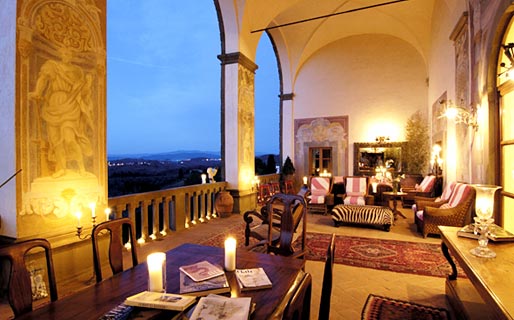
San Casciano
011-39 055 829 0123
www.villamagiacane.com
Just 12 kilometers from Florence, Villa Mangiacane near the small town of San Casciano is actually the private home of South African entrepreneur Glynn Cohen, whose family photos and souvenirs lie throughout the vast 16th century villa, said to have been designed by Michelangelo. The Villa's name--Italian dialect for ‘eat the dog’–refers to the stone dog sculptures that once "guarded" the estate. Originally the Villa belonged to Cardinal Francesco Maria Machiavelli, uncle of Niccolò Machiavelli, then sold in 1645 to the Marchesi Mazzei, whose family maintained it for 300 years.
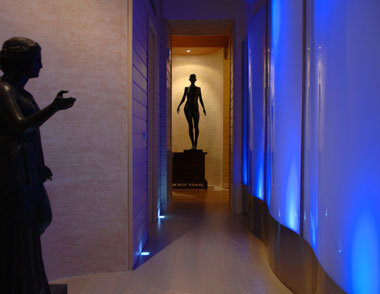 By the time Cohen took possession in
2000 the place was decrepit and falling down, so one can't help be awed
by the pristine condition of the estate now, which includes an
extraordinary Nadushka Spa (left),
which opened last year, run by a delightful
young British woman named Sally Broad. It is also well secluded,
so one is tempted to laze around the pool or on the verandah (above) in
your bathrobe after your treatment and sauna.
By the time Cohen took possession in
2000 the place was decrepit and falling down, so one can't help be awed
by the pristine condition of the estate now, which includes an
extraordinary Nadushka Spa (left),
which opened last year, run by a delightful
young British woman named Sally Broad. It is also well secluded,
so one is tempted to laze around the pool or on the verandah (above) in
your bathrobe after your treatment and sauna.The guest rooms themselves are very large, and it takes some doing just finding them, so labyrinthine is the main structure. You are received cordially by English-speaking hosts, offered a glass of prosecco in the atrium, where a TV plays a loop of Milan fashion shows; then you are shown through a gate and across a rustically landscaped lawn spotted with modern sculpture to the main house. You walk through long hallways beneath arches, across that magnificent verandah. In the morning you can watch the mists rise from this vantage point and later on watch a lazy sun sink below the hills.
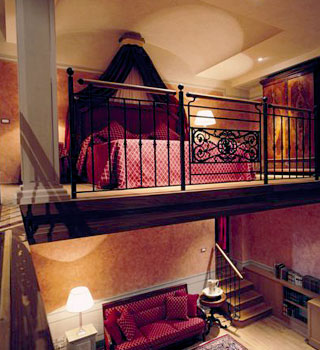 perhaps just to stay put, get some
reading and relaxation in, and have a massage every day.
perhaps just to stay put, get some
reading and relaxation in, and have a massage every day.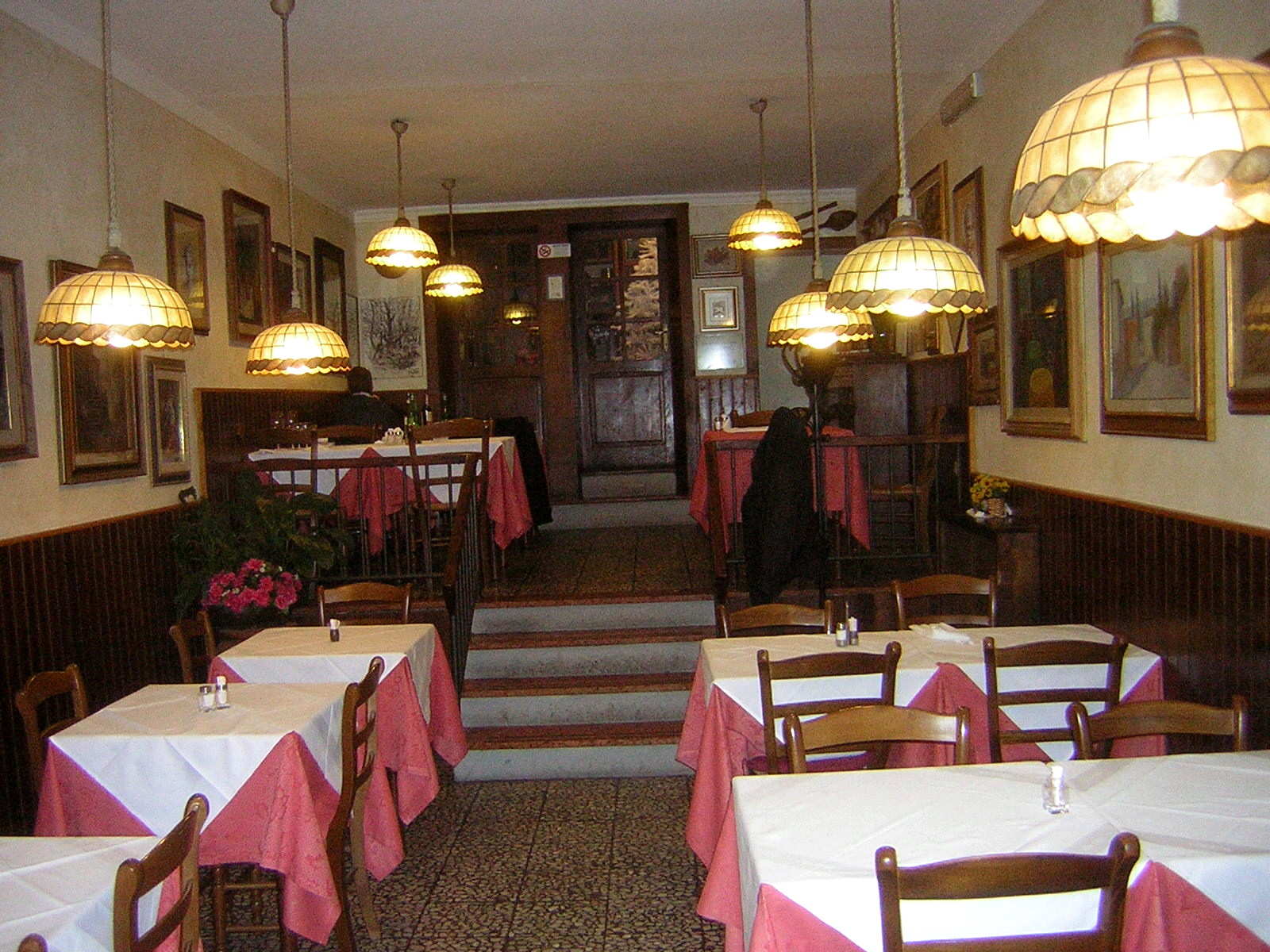 extremely affable staff.
extremely affable staff.The very Tuscan menu looks like it rarely changes but we loved both the food and the very reasonable prices, starting with a platter of mixed salume and meats and chicken liver crostini. Next, a more-than-ample plate of spaghetti alla carratiere, with diced onion, tomato, and red hot pepperoncini, and a cheese-spinach ravioli with a good, hearty ragù. Then we indulged in a hearty bollito misto of tongue, beef, chicken in broth with pickled peppers and carrots--rather bland but very filling. With a bottle of local Chianti, we were very happy, and we headed back to our rooms at the Villa hoping we'd get up in time to watch the sun rise. What with the food and wine, however, somehow we missed it.
The Villa is currently running an "Easter in Chianti" 4-day, 3-night package that incl. a welcome bottle of Chianti and chocolate gift. On Good Friday champagne and canapés followed by a traditional Good Friday candlelight dinner; Italian Brunch on Easter Sunday; Two 50-minutes Spa treatments, Daily Spa access; Rates from €1,200-€ 1,900, for 2 people, with 10% VAT not included. Valid from March 19-24.
Terme di Saturnia Spa & Golf Resort
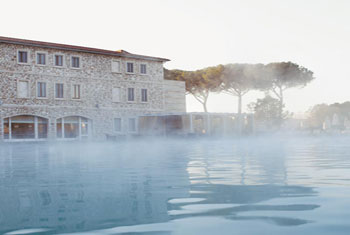
Saturnia, Grossetto
011-39 0564/ 600111
www.termedisaturnia.com
Terme di Saturnia Spa is now in this location, constructed around an ancient travertine heart, with 140 rooms--two Grand Suites, three Suites and 71 Junior Suites--designed according to what they call the Habitat philosophy that strives for harmony of nature, body, and soul, a kind of European feng shue whereby everything from the flooring, lighting, and fabrics has been crafted to provide a sense of complete well being. Now, just this year, they have added a gold course, designed by California architect Ronald Fream. Currently nine holes, the course took a long time to complete because the sulfur content of the soil kept killing off the greens' grass.
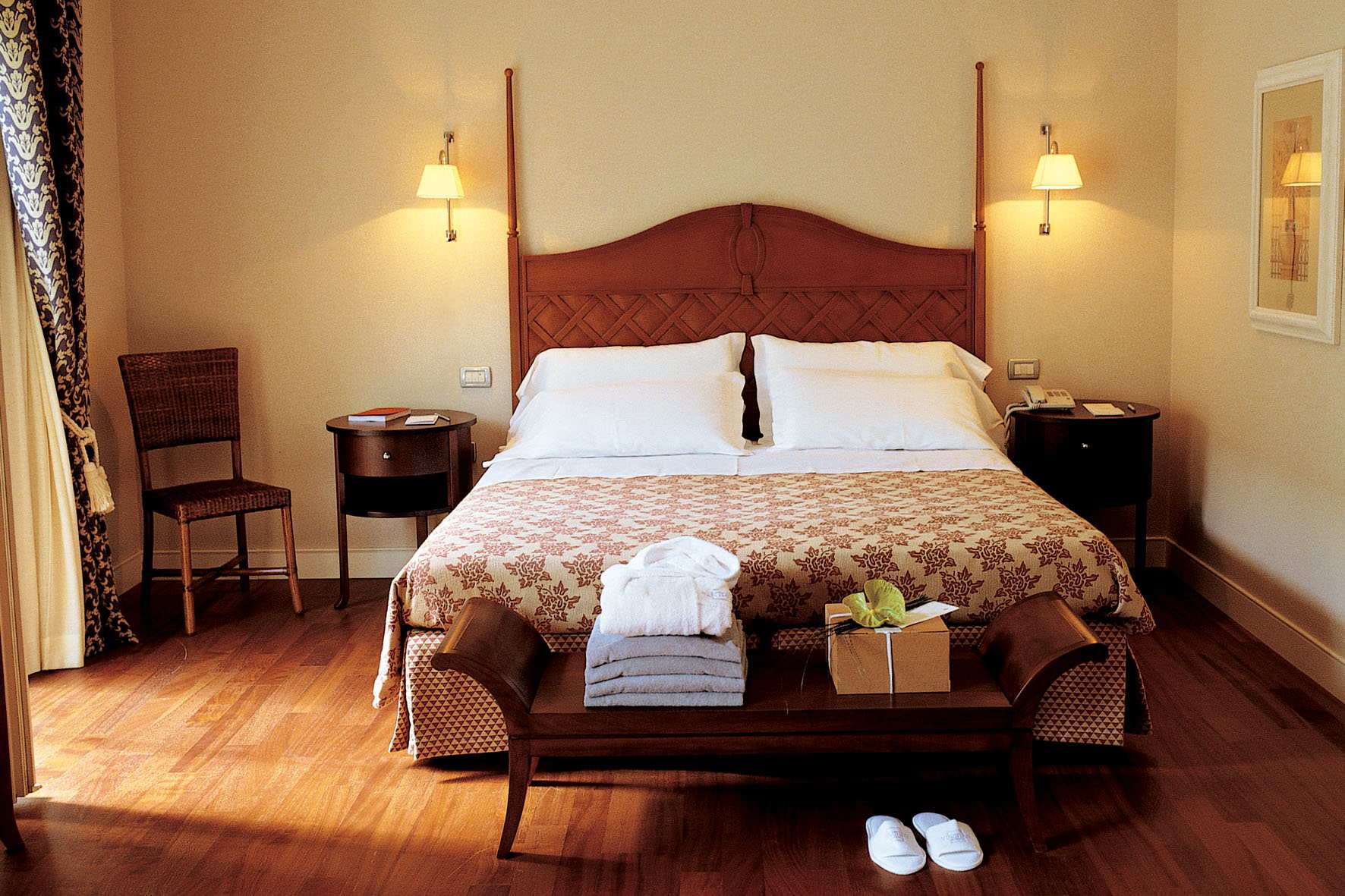 It is difficult to miss the resort along the country road
that sidles it because you can smell it long before you see it.
You turn onto a winding road past the golf course, and you will soon
see the blue-gray steam rising from the baths. The
low-lying building spreads out to the spa rooms, which are extensively
set off hallways lined with some terrific Italian movie posters.
It is difficult to miss the resort along the country road
that sidles it because you can smell it long before you see it.
You turn onto a winding road past the golf course, and you will soon
see the blue-gray steam rising from the baths. The
low-lying building spreads out to the spa rooms, which are extensively
set off hallways lined with some terrific Italian movie posters. The rooms themselves are commodious, well appointed, and quiet, neither posh nor austere, but extremely comfortable, with large bathrooms.
Everybody traipses around in white bathrooms and slippers, some looking haggard on their way to a treatment room, others looking rejuvenated having left one. I fell into both categories: After a long drive in a small car, I arrived at 6:30 PM in knots, all of which were loosened considerably by a soak in the Jacuzzi followed by a very relaxing massage. Other hallways are lined with boutiques where you can celebrate the new gait in your step with the purchase of a cashmere sweater. The outdoor Juice Bar offers fruit and vegetables-based cocktails, smoothies and snacks for those who enjoy such stuff.
I, instead, was ready for sterner stuff in the form of a Daiquiri or two and red wine with dinner at All'Aquacotta (right),
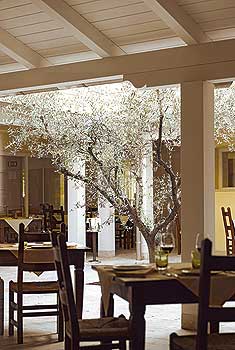 a casual Tuscan restaurant with an
open kitchen; the option is a more refined, continental-style ristorante named Aqualuce,
both overseen by Chef Pier
Luigi Marani. All'Aquacotta is ideal when you are in the mood for
local, rustic cuisine cooked with gusto, and, oddly enough, the
portions are huge, including a tomato stew called pappa al pomodoro, and a very
hearty
vegetable-and-bread soup. Pastas have equal heft--the pappardelle with
wild boar ragù is
terrific--and there is a hefty mixed grill of
several ribs
and sausages, a good buy at €22. The focus here is on meats carved on a
wooden board, both Angus and the beef of the Val di Chianina, including
a
thick,
beautiful bistecca alla fiorentina,
cooked impeccably rare and sliced
at the table into big slabs while still sizzling. The aroma alone
can send you reeling. With this comes roasted potatoes and other
vegetables glossed with Tuscan olive oil. If you can handle
dessert go with the "paradiso di
cioccolato" or the nougat and
chocolate terrine, served with housemade jams.
a casual Tuscan restaurant with an
open kitchen; the option is a more refined, continental-style ristorante named Aqualuce,
both overseen by Chef Pier
Luigi Marani. All'Aquacotta is ideal when you are in the mood for
local, rustic cuisine cooked with gusto, and, oddly enough, the
portions are huge, including a tomato stew called pappa al pomodoro, and a very
hearty
vegetable-and-bread soup. Pastas have equal heft--the pappardelle with
wild boar ragù is
terrific--and there is a hefty mixed grill of
several ribs
and sausages, a good buy at €22. The focus here is on meats carved on a
wooden board, both Angus and the beef of the Val di Chianina, including
a
thick,
beautiful bistecca alla fiorentina,
cooked impeccably rare and sliced
at the table into big slabs while still sizzling. The aroma alone
can send you reeling. With this comes roasted potatoes and other
vegetables glossed with Tuscan olive oil. If you can handle
dessert go with the "paradiso di
cioccolato" or the nougat and
chocolate terrine, served with housemade jams.The winelist here is excellent, specializing first in the wines of Maremma, then Tuscany, then Italy. By the glass there is a sturdy Morellino di Scanzano that goes very well with the beef.
Dinner at All'Aquacotta will run about €40 per person, tax and service, but not wine, included.
|
|
NEW YORK CORNER
by John Mariani
Dovetail
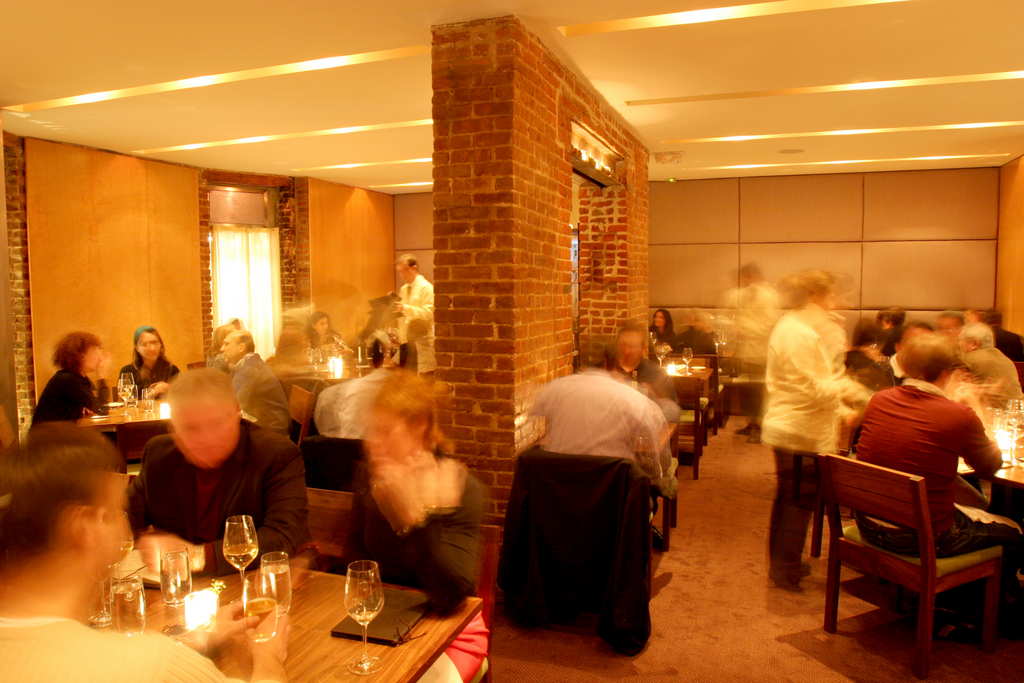
(near
212-362-3800
www.dovetailnyc.com
Now, at Dovetail (whose New Age-y name means "to join together in harmony"), he is spreading his wings and making the cuisine wholly his. At the same time he is adding to the ever-increasing number of fine restaurants in the neighborhood that makes the prospect of dining before theater, ballet, or opera as tantalizing as sitting down to a leisurely dinner after those theater-goers bound from their tables at 7:30 PM. And if you've just left the Museum of Natural History at closing time or at an event, Dovetail is just a few steps away across the street.
Let's get the unpleasantries out of the way: Dovetail is a singularly brown restaurant, the only other color provided by the EXIT sign. The brick walls would help the dreary look of the place but they have been paneled with more brown wood, and the lack of tablecloths on more brown wood makes this a lifeless room indeed, enlivened only by the sound of people obviously enjoying their meal and wine. Some well-known designer supposedly did the place, but were I the owner I'd run right out and buy a claw hammer and rip down the wood panels and install some colorful artwork. Also, at night, the lighting is considerably lower than the photo above indicates.
That said, I highly recommend the food at Dovetail. You will undoubtedly receive an amuse or two: On the night of my visit it was a lovely little rabbit rollatine, an ahi tuna cube, and a very fishy vodka gelée with salmon roe (hence the fishiness) with fried capers. They also serve a terrific cornbread with white cheddar in it, so watch you don't overdo it.
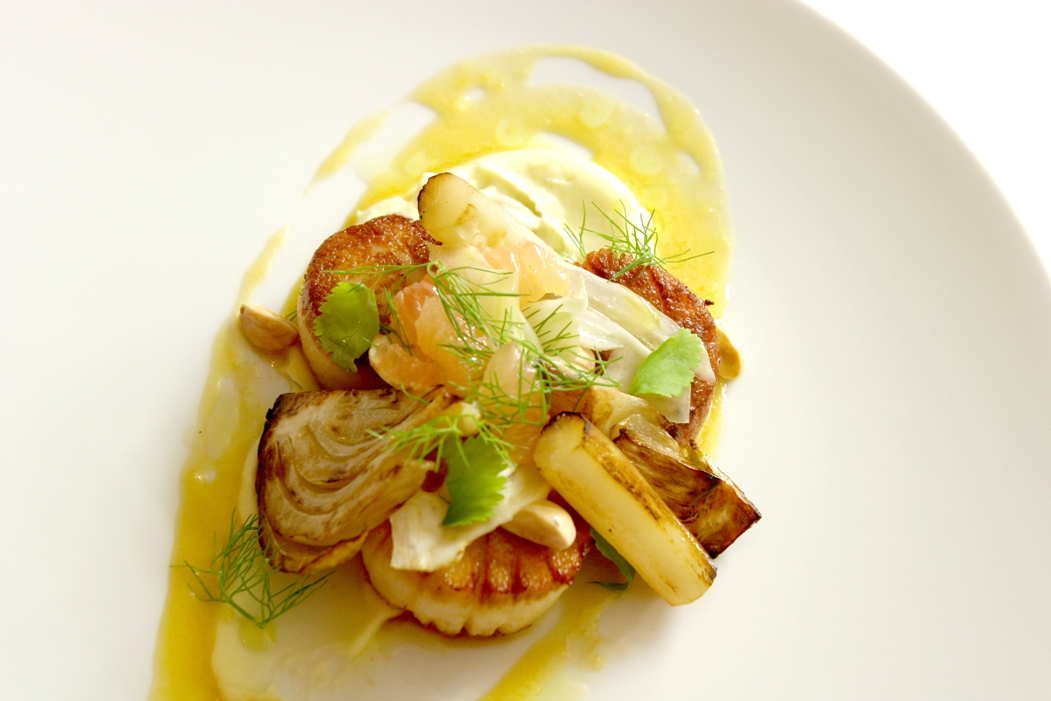 The richness, yet lightness, of a clam
chowder with chorizo made it one of my favorite soups of the year,
while Fraser's take on the now ubiquitous pork belly was a fine
idea--served with porcini,
kale, and a hen's egg. His potato gnocchi is
lavished sensuously with veal short ribs, foie gras butter, and
prunes--not something an Italian chef would bless but a damn delicious
dish anyway. Combining hollandaise with sea scallops (left) is also a bright idea,
because the sauce, tinged with fennel, brings out the sweetness
of the seafood, further enhanced with the tang of grapefruit and the
texture of almonds.
The richness, yet lightness, of a clam
chowder with chorizo made it one of my favorite soups of the year,
while Fraser's take on the now ubiquitous pork belly was a fine
idea--served with porcini,
kale, and a hen's egg. His potato gnocchi is
lavished sensuously with veal short ribs, foie gras butter, and
prunes--not something an Italian chef would bless but a damn delicious
dish anyway. Combining hollandaise with sea scallops (left) is also a bright idea,
because the sauce, tinged with fennel, brings out the sweetness
of the seafood, further enhanced with the tang of grapefruit and the
texture of almonds.Atlantic cod is first seared and served with gigante beans, rock shrimp, and the lovely aromatics of saffron in a nicely seasoned bath. Of the meats I liked very much a rack and leg of lamb with Indian spices, tabouleh and yogurt, considerably more delicate than what you'll find at most Mediterranean restaurants around town, and pistachio-crusted duck with endive, celeriac, and truffles.
There was a long, long wait for Vera Tong's desserts the night I visited, but they were worth it: a quince and pineapple crumble with buttermilk ice cream and walnuts; brioche bread pudding with bananas, rum vanilla ice cream, and the inspired addition of bacon brittle; and chocolate caramel fondant with Earl Grey tea streusel, hazelnuts, and yogurt sorbet.
I could certainly enjoy Fraser's cuisine blindfolded, but when you are paying high-end money for such wonderful food, it sure would be nice to do it in a more appealing dining room than Dovetail is now.
Dovetail is open for dinner nightly. Appetizers run $12 to $16; entrées $28 to $36; $65 six-course tasting. There is a fixed price dinner on Sunday at $38.
NOTES FROM THE WINE CELLAR
Cuvée R. Lalou Hits the Mark by John Mariani
The Mumm Vineyards at Mailly
If that sounds slightly snobbish, given that “Prestiges Cuvées” are those ultra-expensive
My lack of breathless enthusiasm for most of the Prestige Cuvées made by marques like Moët-Chandon, Bollinger, Veuve Clicquot, Roederer, and others is based on three objections: First, they are all very expensive, well above $100 a bottle, some $400 and up. Second, they tend to be bone dry, which is a fashionable and therefore marketable style, but most lack the aroma and pale sweetness of fruit and don’t have as much flavor as I’d expect. Third, they are all vintage
This is a little odd to me, since all these
Which brings me back to R. Lalou 1998, the first Prestige Cuvée has made under this label since 1985, after nine vintages starting with 1966. The wine is named after René Lalou, as chairman of Mumm, restored its luster after the devastation of the vineyards wrought by two World Wars. He died in his room at the
Mumm was bought by Allied Domecq, which let the Cuvée L. Lalou languish; then, in 2005, the house became part of Pernod Ricard, the number two wine and spirits company in the world; Mumm is now the third largest Champagne producer with sales of about 8 million bottles per year (with 60 percent exports to 100 countries).
Meanwhile cellar master Dominique Demarville and his successor, Didier Mariotti, had been working in a corner of the cellars studying the old vintages of the Cuvée. When interested revived in producing a Prestige Cuvée, Mariotti believed the 1998 vintage should be the basis of the new line.
Over lunch at Per Se restaurant in
As soon as I tasted the wine, with canapés of smoked salmon cones and cheese-filled puff pastry, I knew exactly what he meant about it being a wine to go with food. Through the fish and meat courses the wine had brilliance, plenty of fruit, and enormous aroma. I tasted it both well chilled and slightly chilled (in two glasses) and while I found the colder glass brisk and wonderfully sparkling, the warmer glass had lost much of its effervescence. I also had a chance to taste a 1969 R. Lalou, which had not aged well and smelled oddly of varnish.
I asked Mariotti, who is trying to stop smoking (“My palate has apparently adjusted.”), if he would advise the consumer to keep the wine for a few years longer. “Not really,” he said. “We make this
Which gave me the perfect excuse to drink as much of the R. Lalou 1998 that afternoon as I wished, and then wait for the 1999 two years hence.
COMPASSION--THE MOST BRITISH OF VIRTUES
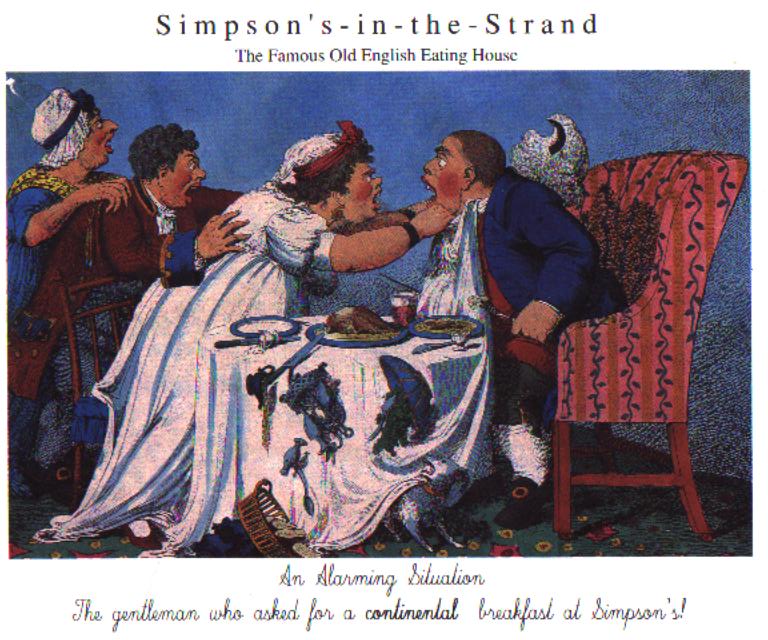
"Perhaps instead of offering fat people money, which they will only spend on pies, we should once again stigmatize them. Fat adults could be forced to pay for two seats on public transport, could be given the worst seats in restaurants and scolded over their choice of dessert. `Have the fruit salad, you fat pig,' and so on."--Rod Liddle, "Laugh at Lard Butts--but Just Remember Fatty Fritz Lives Longer," The Sunday Times
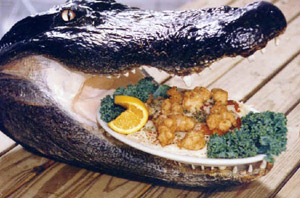 THIS BITES THE BIG ONE!
THIS BITES THE BIG ONE!At the Black Hammock Restaurant in Oviedo, Florida, the menu lists a
QUICK BYTES
* On March 11, Niche Restaurant in
* On March 11 in
* On March 13 in
* On March 17 in
* On March 19, Chef Shawn McClain of Spring in
*
Everett Potter's Travel Report:
Tennis Resorts Online: A Critical Guide to the World's Best Tennis Resorts and Tennis Camps, published by ROGER COX, who has spent more than two decades writing about tennis travel, including a 17-year stretch for Tennis magazine. He has also written for Arthur Frommer's Budget Travel, New York Magazine, Travel & Leisure, Esquire, Money, USTA Magazine, Men's Journal, and The Robb Report. He has authored two books-The World's Best Tennis Vacations (Stephen Greene Press/Viking Penguin, 1990) and The Best Places to Stay in the Rockies (Houghton Mifflin, 1992 & 1994), and the Melbourne (Australia) chapter to the Wall Street Journal Business Guide to Cities of the Pacific Rim (Fodor's Travel Guides, 1991). Click on the logo below to go to the site.
~~~~~~~~~~~~~~~~~~~~~~~~~~~~~~~~~~~~~~~~~~~~~~~~~~~~~~~~~~~~~~~~~~~~~~~~~
MARIANI'S VIRTUAL GOURMET NEWSLETTER is published weekly. Editor/Publisher: John Mariani.
Contributing Writers: Robert Mariani,
Naomi
Kooker, Suzanne Wright, John A. Curtas, Edward Brivio, Mort
Hochstein, Suzanne Wright. Contributing
Photographers: Galina Stepanoff-Dargery, Bobby Pirillo. Technical
Advisor: Gerry McLoughlin.
Any of John Mariani's books below
may be ordered from amazon.com by clicking on the cover image.
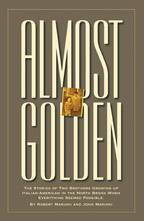 My
newest book, written with my brother Robert Mariani, is a memoir of our
years growing up in the My
newest book, written with my brother Robert Mariani, is a memoir of our
years growing up in the For those of you who don't think of the Robert and I think you'll enjoy this very personal look at our --John Mariani |
 |
 |
 |
 |
 |
 |
© copyright John Mariani 2008

